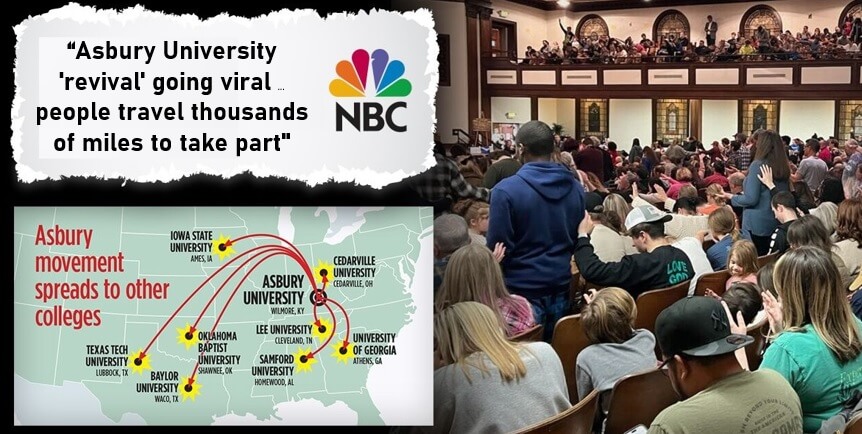
By Jason Williams
Williams is a researcher, writer and founder of the Taxpayers Association of Oregon.
— I went to the Asbury University Awakening movement and interviewed students for three days to do a journalistic deep dive on what we can learn from this youth phenomenon. When you witness tens of thousands of young people from all over America hold a non-stop event (sometimes all night) for two weeks, it calls for our attention. What I found greatly inspired me and filled me with pride for America’s younger generation.
Quick history of awakening movements and their impact on America
America has experienced religious awakening movements in the past. The first two so-called Great Awakenings created a burst of patriotism, national identity, and liberty that helped play a role in launching the Revolutionary War.
Another similar religious movement gave birth to the abolition of slavery.
Yet, another awakening movement led to the national prohibition of alcohol with the 18th Amendment (later repealed in 1933).
All people of both religious and secular philosophies should pay close attention to religious awakening movements to see what is happening, where it may go and what issues they may spark. The Asbury movement has already caught fire among eight college campuses.
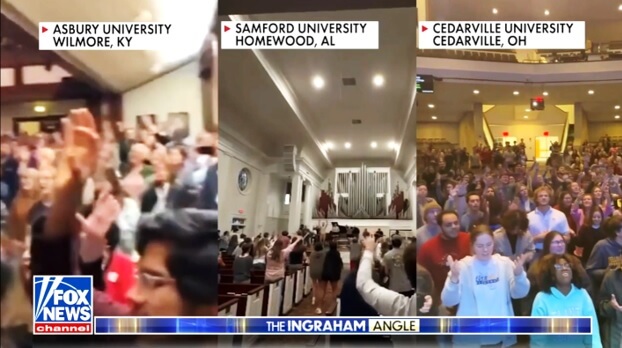
What started the Asbury awakening.
The Asbury University awakening movement started during a routine 10 a.m. mandatory student chapel service. The sermon was given by a soccer coach who found himself unprepared, so he took the opportunity to speak unscripted from the heart on very personal, painful, and honest matters. He ended by asking people who were hurting to remain after the service for prayer. Nineteen students stayed. They began to share their struggles with each other, pray, and sing together. It was so powerful they couldn’t stop. They continued to pray and sing all afternoon. Soon, word spread on campus, and people flooded to the chapel where they sang, prayed, and shared stories all night long. They continued for 150 hours. Within days, some 40,000 people descended on a small town of 2,000 to participate.

What I witnessed.
I drove into Asbury University, astounded by the size of the crowds, awestruck by the line of a thousand mostly young people seeking to enter the main chapel where students had been praying and singing nonstop in the main chapel since Feb. 8. Several meeting halls ran live broadcasts (see above), all packed.
People flocked from everywhere. I met a youth pastor who just arrived off a plane from London eager to observe what is happening here and share it with England. I was constantly surrounded by people who just arrived from all over America. One young Hispanic man got off work and drove straight from New Jersey. Another man with his family arrived from Florida after driving all night nonstop. One young man with double-sided nose piercings said he is not religious, but rather, “I came to see what this Christ has to offer.” It doesn’t get more viral than this.
I waited in line to enter a smaller chapel on campus with a live broadcast of services that had continued for 12 hours straight. The atmosphere, electric yet sober, prompted people to sing and jump for joy—so much so that university officials asked those jumping in the wooden balconies to climb down to the main floor to prevent a balcony collapse. One young speaker from the chapel said we need to practice “radical humility” followed by loud cheers from the crowd. Where else do you see a thousand young people cheer the call to be humble?
Covid had thoroughly wrecked the mental state of young people.
One of the lessons I learned from people attending was how damaged and isolated everyone had become during the pandemic. One young woman who drove from Texas shared with me that she was so terrified during the Covid-19 pandemic that she locked herself in her bedroom for months, even giving her neighbors her cat to take care of. She said God helped pull her out of her hole and now she was there in Asbury wanting more of God who dramatically quashed her fears and made her into a new person. Thanks to God, she vows never to live in fear again.
A young Asbury college student was overwhelmed by what he called “extreme loneliness.” He confessed he escaped into drugs and alcohol, erecting a brick wall to keep out the world —until the very moment he attended the chapel service. “God struck me!” he exclaimed. The brick wall crashed, and he has never felt so alive and close to people in his life. At the same time he shared his story, another Asbury student shared a similar experience of overcoming severe isolation and finding dramatic renewal at the chapel service. It was as if the damage done by the pandemic on America’s youth was reversing itself in real-time, before your very eyes.
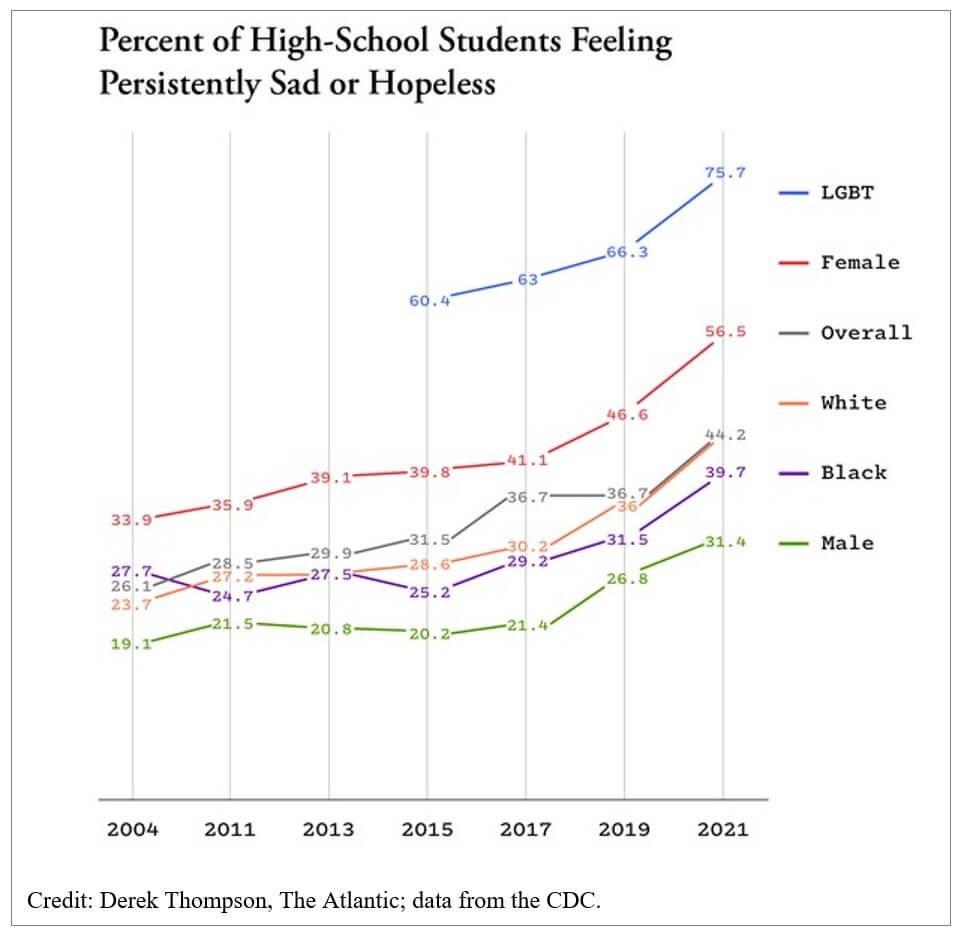
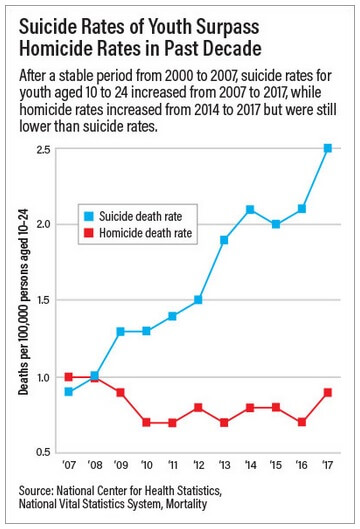
As the charts shows, America’s youth are drowning in an ocean of depression in staggering levels. Asbury represented a chance to break out.
Modern media forces pornography on unwilling youth
I spoke with a circle of young men outside the chapel who shared horror stories of how they struggle to escape pornography. One angry man said TikTok keeps pushing videos of scantily dressed women doing sexual dances and other antics. He simply can’t get TikTok to stop doing it. A young man from the Middle East confessed, “I can’t watch a single Netflix show” because they always include inappropriate scenes as if it were mandatory. Even a young woman in this circle of friends said she is tired of all the unsolicited pornography she sees online. A third man in the circle summed up their dilemma. “We are trying to save ourselves for marriage, but these things are making it impossible.”
Wow! Here are young men trying to be the best they can be for their future wives, but they’re saying it feels impossible. “We can’t escape it” was a common theme. They arrived at Asbury seeking hope.
By sheer coincidence, I spoke with a Black student mere moments earlier who shared how Facebook keeps pumping adult-themed ads into his news feed. Like the TikTok man, he too can’t get Facebook to stop it no matter how hard he tries. These men feel trapped because social media is where all their friends share their content and talk to each other, and sites like TikTok, Facebook, and Instagram are pummeling them with sexually obscene content against their wishes. It is important to note that during my interviews, I asked only what struggles and concerns their generation faces. These men brought up on their own the issue of pornography as a chief concern.
During a sermon at the Asbury chapel service, a pastor addressed that very subject, saying he met three young men who drove nonstop from a college in Indiana begging for relief from pornography struggles. One young man admitted he had flooded his mind so much with pornography he couldn’t talk to women anymore; he was so overcome with crippling shame.
Their stories bring to light what doctors have been sharing: a sudden increase in men in their twenties experiencing clinical sexual dysfunction with their partners. Addiction is completely rewiring their natural human functions.
These students found healing at the Asbury Awakening, relief after confessing their struggles, and hope for overcoming them.
Social media creates perfection prisons, inability to be human.
Social media has trapped young women in a completely different way, by creating a prison of perfection that stifles them from sharing how they actually feel. Posts highlight perfect lives, not personal struggles, and pressure builds to hide any flaws. The struggle to maintain a perfect presence profoundly affects their private lives. One woman in line to attend the chapel told me at one point she lost the ability to cry around people out of fear. This fear is felt even when women gather in church youth groups, where the conditions are safe and healthy to share personal struggles and ask for prayer, but they often don’t.
Compounding this “never share” fear is today’s cancel culture, which actively seeks out, targets, and harasses those who share unpopular thoughts and feelings. The young people feel that anything they say may be targeted. This targeting is not an exaggeration. I remembered hearing the story of Keri Smith, a young media producer, who was among the first to bring cancel culture to modern cable comedy shows. She woke up every morning looking online for anything that violated her beliefs to pounce upon. Now, imagine tens of thousands of such censors across America. She eventually broke away from this cult-like obsession and now runs Civility Dinners to foster communication. Just yesterday, as I was completing this article, the popular music magazine among youth, Rolling Stone, issued an article calling cancel culture good for America. Just a few weeks ago, a Disney cartoon for middle schoolers, The Proud Family, showed two examples of kids benefiting from publicly shaming others online. That’s right, cartoon characters instructing middle schoolers to cancel and publicly shame their friends.
At the same time, mainstream religion has the impossible task of confronting this extremely dangerous corrupt cultural tidal wave and trying to eradicate all signs of it within their congregations. This has made some of the young women I talked with afraid to share with others such sensitive topics as identity, sexuality, doubts, or relationship struggles. These women wish they could share more. They describe it as if they are almost there but can’t muster the last ounce of courage to do it.
This is where the Asbury awakening broke through.
These women saw videos of the Asbury revival broadcast online where young women, like themselves, freely shared their flaws and failures before a crowd. “I am desperate for that,” one woman said to me. They want to open up, be real, and find acceptance for who they are, where they are.
“I want to be myself all the way through,” a Black student who drove from Tennessee said to me. She added that she yearned to find people who would let her do just that. Then she offered a profound confession. “I have to be completely honest. We also need to blame ourselves.” She further explained that we need to take responsibility when it comes to not opening up to our friends and in our church communities. We all know we should do it. We can do it. But we don’t. Everyone is waiting around for the first person to stand up and start. We need to stop waiting and just do it. I was taken aback by this young woman’s frankness and wisdom, which made me a strong believer in the emerging generation.
Asbury became the signal that shone through the darkness, a safe place where students openly confessed their problems and struggles. One student while worshiping at Asbury felt that God told her to forgive her father for something hurtful he did long ago that she held against him. She immediately went to find him and apologized to him. She shared to the whole audience that they had a good relationship before, but by releasing this hidden spot of bitterness, it helped heal her instantaneously. Now her closeness to her father is even greater than it has ever been. She was sharing her story with such excitement it was like she won the lottery. Watching sons and daughters reconcile with their mothers and fathers is a rare yet beautiful sight. Where else do you see this in public?
Asbury student Gracie Turner was interviewed by the Bari Weiss podcast, as she shared her story of losing her faith after watching her great-grandmother die of cancer. Gracie said, “I was too scared to tell my parents that I had lost my faith. I remember I resented God. There was a lot of times I was so homesick…I would lie in bed and sometimes pray to God, saying ‘It would be really nice if I didn’t wake up tomorrow’. I was so depressed.” Full of despair and suicidal thoughts, Gracie went to the chapel service and felt overwhelmed by the joy and feelings. She said, “I just cried because the emotions I was feeling were so overwhelming. Then I got up and shared my testimony in front of more than a thousand people, and I have the worst anxiety ever. Yet I stood up there, crying, telling people that this week I had been so depressed and feel like I am at my end, and this revival happens on the day I feel like I am at my breaking point. I feel relieved. I feel better. I feel like God is steering me back to Him.”
This experience of ordinary people suffering from terrible depression and suicidal thoughts and then witnessing immediate healing and having the courage to share their story before the world is emboldening young people across the country to get in their cars and drive long distances to experience it themselves.
My heart melted when I spoke with two charming and humble Asian high school students who stood for five hours in the cold at Asbury to enter the chapel where they could find people their age who share their faith. At their large public school, they feel so painfully alone, even though they know they aren’t the only Christians.
“We just want someone to have courage, to come forward and organize something,” the girls said.
Like so many who flocked to Asbury, they wanted something more than what they find at local religious services. They wanted real connections with others who accept them as they are.
Honoring and serving the younger generation.
Another standout element of Asbury is how the older generations are supporting the students. This is a student-led movement. The university opened the chapel to students all day and all night. People under 25 led the music and gave most of the sermons.
One older speaker at the podium addressed the students, saying, “We believe in you!” and “We are all so proud of GenZ!” I’d never heard such a statement “proud of GenZ” spoken by another human before. Mostly because older people most often complain about the younger generations. Not here. Not at Asbury.
One student shared a testimony online: “Look left and this young college woman is getting prayed over by an older woman; look right and there’s this young guy praying over an older guy. It’s ordinary people crying out from a love of God.”
The intergenerational unity warmed my soul. In the 1990s, I attended one of the largest and most active churches in Portland, Oregon. Out of nowhere, divisions arose between the older generation and the younger generation, conflicts over music, sermons, and other matters. Before long, the church fell apart. It no longer exists. That fate awaits other organizations that fail to find a way to embrace intergenerational unity.
Asbury provides a role model forward.
An older pastor in the chapel spoke at the podium, saying, “The younger generation is rapidly evacuating from the church, and they are sending us a clear message in doing so.”
I found the Asbury attendees want more, a faith relevant to their lives, beliefs that offer power to help them tackle the oversized struggles they face. They want real people speaking from one heart to another, embracing each other with love and acceptance, acknowledging difficulties while offering hope for the future.
“I’m looking for something more.” I heard the phrase time and again from the people at Asbury.
What drew people to Asbury reflects America’s larger struggle amid a staggering decline in church attendance.
Interestingly, while longstanding mainstream religions have lost members, the nation’s largest religious organization—the Catholic church—has bucked the trend and gained two million members in the past decade. This bucks the stereotype of young people wanting only a more hip, modern, entertaining watered-down theology.
What is going on in the Catholic faith? Has it become fashionable? In addition to the impact of immigration, the church has seen a rise from a Catholic Charismatic Renewal movement within the religion. While preserving core Catholic traditions and sacraments, the movement also focuses on Spirit-led activities, more prayer, and a personal relationship with God. Although many Catholic parishes are closing across America, others parishes are thriving and growing through this new movement. This same renewal movement is also why some evangelical churches are growing while traditional Protestantism is declining. While people look at surveys showing a decline in religion, they fail to look deeper at the numbers which show a dramatic re-shifting where traditional forms are declining but more engaged, active renewal movements are expanding within the decline.
At its core, the Asbury Awakening, while a sociological event, is a movement of people changing their lives in immediate and tangible ways as they encounter God.
It’s a viral social movement focused on God, changing lives through Him rather than gaining “likes” or “followers” on a personal level. Although it’s drawn media attention, the focus remains on encountering God through amazingly short sermons, worship songs, and testimonies. When Fox News asked to record from inside the chapel, university officials refused, saying they wanted no distractions to what was happening inside those doors.
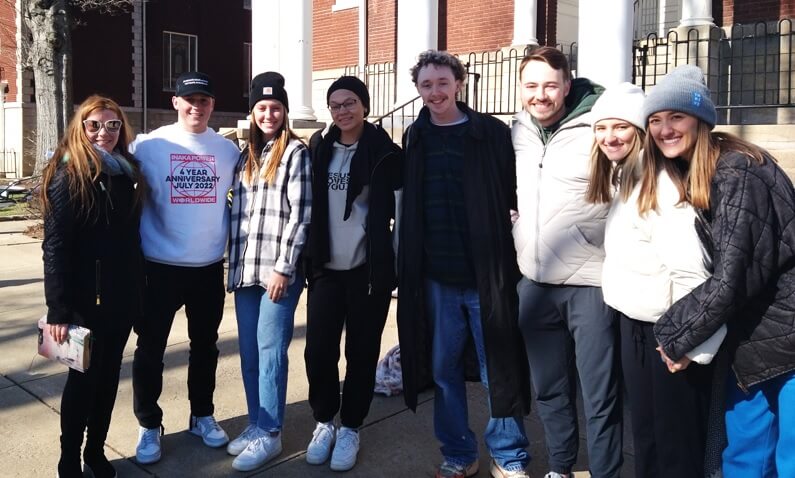
Photo: These people standing in line in the cold for five hours whom I interviewed were amazingly articulate, inspirational to me, and also represented different states, countries, races and backgrounds.
What hindered the Asbury awakening.
On Friday night, I attended an incredible service at Estes Chapel, across from the main chapel. It is an amazing experience to see every single person in the room singing with their full measure and being elevated by it all. If people didn’t know the words to a song, you could tell they were trying the best to learn them and participate. During an altar call, several young men and women were kneeling and seeking repentance. The sobbing heard was deep and profound, signs of deep change.
The following evening, I returned to Estes Chapel, where the atmosphere, although lively, was much milder than the night before. Upon observation, I noticed that the service drew more spectators (people who watched) than participants. This directly affected the atmosphere of the room. These spectators didn’t sing as often as everyone else. They glanced at their cell phones frequently. They focused on other people rather than what was happening in front of them.
Here is the interesting thing: Of these spectators (more likely to be distracted or just observers), 100 percent of them were older than 25. Although most older people participated, those that made up the spectators were all non-young people. Every young person I witnessed was engaged in the moment. What a flip of reality where, at a life-changing event, it is the older adults (25-plus) that are distracted by their phones and where the younger ones were paying attention.
Even more absurd, was that these youth were singing many classical religious hymns 100 years old while many 25+ people sat and didn’t sing. What backwards world did I stumble into?
This is a striking metaphor for the future of the Asbury Awakening movement and the future of other movements in that waves of change won’t happen if too many people choose to be spectators over participants. People are more eager to take photos of a change event than to create a change event. This is why at Asbury University they forbid people from taking videos to prevent them from interfering with the experience of others.
It was more about personal change more than a campaign
In another break with convention, one speaker from the podium flat out said that they do not care about the numbers. Their top concern was not how many people showed up nor how many people changed their beliefs. The speaker emphatically said what he cares most about “depth” of change. They wanted to people to be changed all the way to the soul in a transformational way with God. If people are changed for the better, from depths of who they are, then they will go out and change others and change the world and it will all take care of itself.
This was sound wisdom for a movement. Legendary speakers like Billy Graham could draw huge crowds and get 1,000 people to come down to an altar call to change their lives. Yet, studies showed that upon follow up that only a third of those who went down to the altar call found themselves in a faith community, church or religious group a few years later. Most people fell away. Graham did his job, but the town he visited didn’t do theirs. Americans are eager to draw crowds and win converts, but often miss on the truer, harder, more long-lasting work of building relationships and investing deep into people. This is just another impressive way Asbury stands out by rejecting the hype and temptations of crowds, fame and quick answers, and instead focusing on a transformative soul change and healing among a trouble people.
Hope for America
The student-led Asbury Awakening offers a renewed birth of optimism. It comes at a time for our nation when many people see a hostile society—government, media, schools, culture—that has turned against them. That’s exactly how people throughout Eastern Europe and the Soviet Union felt in the 1980s when communism controlled the government, media, schools, and culture. Then, without warning, without signs, the entire empire fell in less than 400 days.
A social movement birthed in liberty, and complemented by the local church, sprang up in Poland and spread like a pandemic, toppling communist dictators, one by one. Seven different nations, under oppression for almost a half-century, were liberated in about one calendar year. No one predicted it. No one saw it coming. Some communist leaders at the time implemented widespread arrests and killed as many protesters they could find. It didn’t work. The movement grew too fast and too strong. The idea of liberty had arrived and one of the biggest empires the world has ever seen was utterly helpless to stop it.
If you want a vision for the future, look to the past.
I find great inspiration in reading history when we triumphed over tyranny. I find great inspiration in the survival stories of the Jewish people in the Holy Bible who stood up against some of histories biggest empires — Egypt, Babylon, Assyria.
As I speak, Asbury has spread to eight other college campuses.
I had faith in the younger generation before, but by seeing it with my own eyes, my hope is renewed even greater.
End Note: To protect the privacy of students I do not feature names, but rather use various identifiable characteristics to provide some level of detail. Mentioning race was specifically used because critics of Asbury already and falsely attack the movement as too white — when it clearly wasn’t.
Disclaimer: Articles featured on Oregon Report are the creation, responsibility and opinion of the authoring individual or organization which is featured at the top of every article.



